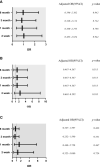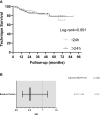Break-in Period ≤24 Hours as an Option for Urgent-start Peritoneal Dialysis in Patients With Diabetes
- PMID: 35909563
- PMCID: PMC9329536
- DOI: 10.3389/fendo.2022.936573
Break-in Period ≤24 Hours as an Option for Urgent-start Peritoneal Dialysis in Patients With Diabetes
Abstract
Background: The optimal break-in period (BI) of urgent-start peritoneal dialysis (USPD) initiation for patients with end-stage renal disease (ESRD) and diabetes is unclear. We aimed to explore the safety and applicability of a BI ≤24 h in patients with ESRD and diabetes.
Methods: We used a retrospective cohort design wherein we recruited patients with ESRD and diabetes who underwent USPD at five institutions in China between January 2013 and August 2020. The enrolled patients were grouped according to BI. The primary outcomes were mechanical and infectious complication occurrences, whereas the secondary outcome was technique survival.
Results: We enrolled 310 patients with diabetes, of whom 155 and 155 patients were in the BI ≤24 h and BI >24 h groups, respectively. The two groups showed a comparable incidence of infectious and mechanical complications within 6 months after catheter insertion (p>0.05). Logistic regression analysis revealed that a BI ≤24 h was not an independent risk factor for mechanical or infectious complications. Kaplan-Meier estimates showed no statistically significant between-group differences in technique survival rates (p>0.05). Cox multivariate regression analysis revealed that a BI ≤24 h was not an independent risk factor for technique failure.
Conclusion: USPD initiation with a BI ≤24 h may be safe and feasible for patients with ESRD and diabetes.
Keywords: break-in period; complications; diabetics; end-stage renal disease; urgent start peritoneal dialysis.
Copyright © 2022 Hu, Yang, Sun, Zhang, Zhu, Zhou, Wen, Liu and Cui.
Conflict of interest statement
The authors declare that the research was conducted in the absence of any commercial or financial relationships that could be construed as a potential conflict of interest.
Figures



Similar articles
-
Feasibility of a break-in period of less than 24 hours for urgent start peritoneal dialysis: a multicenter study.Ren Fail. 2022 Dec;44(1):450-460. doi: 10.1080/0886022X.2022.2049306. Ren Fail. 2022. PMID: 35272577 Free PMC article.
-
Safety of a 24-h-or-less break-in period in elderly patients undergoing urgent-start peritoneal dialysis: A multicenter retrospective cohort study.Ther Apher Dial. 2023 Apr;27(2):304-313. doi: 10.1111/1744-9987.13907. Epub 2022 Jul 11. Ther Apher Dial. 2023. PMID: 35765766
-
Complications and outcomes of urgent-start peritoneal dialysis in elderly patients with end-stage renal disease in China: a retrospective cohort study.BMJ Open. 2020 Mar 23;10(3):e032849. doi: 10.1136/bmjopen-2019-032849. BMJ Open. 2020. PMID: 32205371 Free PMC article.
-
Urgent-start peritoneal dialysis: is it ready for prime time?Curr Opin Nephrol Hypertens. 2019 Nov;28(6):631-640. doi: 10.1097/MNH.0000000000000545. Curr Opin Nephrol Hypertens. 2019. PMID: 31436551 Review.
-
Unplanned Start on Peritoneal Dialysis Right after PD Catheter Implantation for Older People with End-Stage Renal Disease.Perit Dial Int. 2015 Nov;35(6):622-4. doi: 10.3747/pdi.2014.00347. Perit Dial Int. 2015. PMID: 26702001 Free PMC article. Review.
Cited by
-
Immediate-start peritoneal dialysis without break-in-period: an 18-year retrospective cohort study on patient survival.Kidney Res Clin Pract. 2025 Mar;44(2):338-348. doi: 10.23876/j.krcp.23.103. Epub 2024 Feb 19. Kidney Res Clin Pract. 2025. PMID: 38389148 Free PMC article.
-
Risk factors of different mortality periods in older patients with end-stage renal disease undergoing urgent-start peritoneal dialysis: a retrospective observational study.BMC Geriatr. 2024 Apr 15;24(1):343. doi: 10.1186/s12877-024-04931-4. BMC Geriatr. 2024. PMID: 38622550 Free PMC article.
References
Publication types
MeSH terms
LinkOut - more resources
Full Text Sources
Medical

